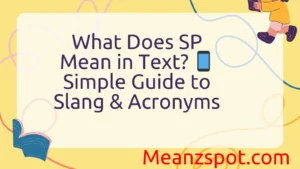Ever come across Uhm in text and wondered what it really means? 💬 In today’s fast-paced world of slang and online conversations, small expressions like uhm carry a lot more weight than you might think. From casual chats on WhatsApp and Snapchat to trending TikTok comments and Instagram captions, uhm has become a go-to filler word that shows hesitation, thought, or even mild sarcasm. 😅
In this guide, we’ll explore the true meaning of uhm in text, how people use it across different platforms, and the updated ways it appears in 2025 digital slang. You’ll see examples, variations, and replies so you’ll always know exactly what the other person means when they drop a simple uhm in your chat. ⚡
Definitions & Meaning
“Uhm” is a textual representation of the spoken interjection “um,” used primarily to indicate a pause, hesitation, or uncertainty in speech. When translated into written communication—especially in texting, chat messages, or online forums—“uhm” retains this role but also carries additional connotations depending on tone and context.
At its core, “uhm” serves the following purposes:
- Hesitation: It shows that the speaker or writer is unsure or thinking.
Example: “Uhm, I’m not sure if that’s the right answer.” - Politeness or Indirectness: Sometimes it’s used to soften a potentially critical or awkward statement.
Example: “Uhm, I think your mic is muted.” - Passive resistance or disagreement: It can signal discomfort or a lack of agreement without direct confrontation.
Example: “Uhm… I don’t really think that’s true.” - Attention signal: In group chats, it may be used to draw attention politely.
Example: “Uhm, guys, did anyone see my earlier message?”
Tone plays a huge role in how “uhm” is interpreted. While some may use it playfully, others may rely on it to gently ease into difficult conversations. In short, “uhm” is not just a filler—it’s a communicative tool that helps convey the emotional layer behind text-based interactions.
Origins & History
The use of “uhm” in text stems from the spoken interjection “um,” which is itself a vocalized pause commonly used in conversation. Linguists refer to these as “filled pauses,” which are sounds people make to fill silence while thinking or organizing their thoughts. The origins of these filler words are deeply rooted in speech patterns across nearly every known language.
Historically, “um,” “uh,” and “uhm” have existed as natural parts of human speech. They appear even in ancient transcripts and texts, indicating that the function of vocalized hesitation has always played a role in verbal communication.
As language moved into the digital space, especially with the rise of instant messaging and texting in the late 1990s and early 2000s, people began transcribing spoken conversation into written form more directly. That’s when terms like “uhm” began showing up in texts, chatrooms, and forums.
Over time, “uhm” became a stylistic choice for users who wanted to mirror natural speech in text, signaling that their digital communication wasn’t stiff or overly formal. Today, “uhm” is firmly entrenched in online vernacular and continues to evolve with how people express themselves digitally.
Usage in Different Contexts
“Uhm” adapts fluidly across a range of digital environments. Its interpretation often depends on the platform, the relationship between participants, and the tone of the conversation.
1. Social Media
On platforms like Twitter, Instagram, or TikTok, “uhm” is frequently used for comedic or dramatic effect. It often signals disbelief, judgment, or ironic hesitation.
Example: “Uhm… did he really just say that?”
Memes and comment threads use “uhm” to pause for effect, creating a sense of timing similar to that of stand-up comedy.
2. Casual Texting
In personal messages between friends, “uhm” often communicates politeness or awkwardness.
Example: “Uhm, I kind of forgot we had plans today.”
Here, it softens admissions or requests, making the tone feel less confrontational.
3. Professional Settings
Though less common in formal emails, “uhm” may appear in internal chats (e.g., Slack or Teams) where a casual tone is acceptable. It helps convey uncertainty or a polite suggestion.
Example: “Uhm, could we revisit that deadline?”
Used sparingly, it can make the sender appear more human and considerate, but overuse may reduce perceived professionalism.
4. Pop Culture and Entertainment
“Uhm” has become part of scriptwriting, fanfiction, and storytelling, often indicating a character’s emotional hesitation or internal conflict. It helps readers “hear” the tone even in silent mediums.
Across all these contexts, “uhm” remains a flexible tool that blends linguistic function with emotional nuance.
Common Misunderstandings & Clarifications
Despite its widespread use, “uhm” is often misunderstood. Some see it as a typo or mistake, while others may misinterpret its tone altogether.
1. “Uhm” vs. “Um”
While both are acceptable, “uhm” is often perceived as more drawn-out or expressive. “Um” may come off as more neutral or abrupt, while “uhm” suggests a more thoughtful or uncertain pause.
2. Tone Misinterpretation
Text lacks vocal cues, so “uhm” can sometimes be misread. A well-intentioned pause might be taken as sarcasm, reluctance, or even annoyance.
3. Seen as Unprofessional
Some people view filler words like “uhm” as signs of poor communication or nervousness. In formal writing, it’s best to avoid them unless you’re intentionally mimicking speech for tone.
4. Mistaken for Passive-Aggressiveness
In some contexts, especially where tone is ambiguous, “uhm” might be seen as a passive-aggressive lead-in to criticism.
Example: “Uhm, maybe next time check the email thread first?”
Clarity is key—pairing “uhm” with explicit politeness can help avoid confusion.
By understanding these nuances, you can use “uhm” more effectively and avoid potential miscommunication.
Alternatives & Synonyms
If you want to express hesitation or thoughtfulness but feel that “uhm” doesn’t quite fit, there are plenty of other options:
- “Um”: The standard, more commonly used variant.
- “Er” or “Eh”: Often used in British English or more casual contexts.
- “Well…”: A softer way to ease into a response.
- “I mean…”: Useful when clarifying or adjusting a previous point.
- “Let me think…”: A clearer expression of genuine pause or reflection.
- “So…”: Can function as a transition or pause, depending on usage.
Each of these carries its own tone and degree of formality. Choosing the right one depends on your audience and intent.
Frequently Asked Questions (FAQ)
1. Is “uhm” a real word?
Not officially in most dictionaries, but it’s a recognized interjection in informal writing and digital communication.
2. What’s the difference between “uhm” and “um”?
“Uhm” is a more expressive variation, often used to convey a longer or more pronounced pause than “um.”
3. Can I use “uhm” in professional emails?
It’s best to avoid it in formal emails. However, it can be acceptable in casual workplace chats or messages to teammates.
4. Why do people use “uhm” in texts?
To mirror spoken conversation, express hesitation, or soften their tone in delicate situations.
5. Is “uhm” passive-aggressive?
Not inherently, but it can come off that way if used before criticism without clear context.
6. How do I know if I’m overusing “uhm”?
If it appears in nearly every message or sentence, consider using it more sparingly or replacing it with other transition phrases.
7. Is it okay to correct someone for using “uhm”?
Only if the context is formal or academic. In casual settings, it’s generally acceptable and often part of natural digital language.
Conclusion
“Uhm” may seem like a small, insignificant expression, but in the digital world, it plays a surprisingly versatile role. Whether you’re showing hesitation, being polite, or adding a touch of personality to your text, “uhm” helps bridge the gap between spoken and written communication. Its subtle influence on tone and clarity makes it a valuable tool—when used thoughtfully.
As with many elements of digital language, context is everything. Understanding the nuances of “uhm” not only improves your communication skills but also helps you interpret others’ messages more accurately. So next time you see or use “uhm” in a conversation, you’ll know that there’s more going on beneath the surface than just a pause.



